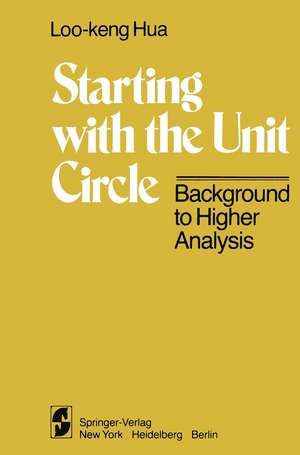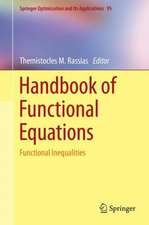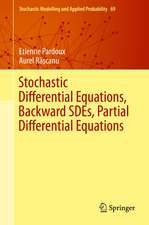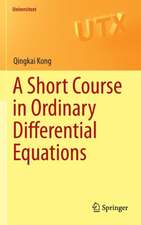Starting with the Unit Circle: Background to Higher Analysis
Autor L. K. Hua Traducere de K. Weltinen Limba Engleză Paperback – 6 noi 2011
Preț: 382.18 lei
Nou
Puncte Express: 573
Preț estimativ în valută:
73.13€ • 78.20$ • 60.97£
73.13€ • 78.20$ • 60.97£
Carte tipărită la comandă
Livrare economică 18 aprilie-02 mai
Preluare comenzi: 021 569.72.76
Specificații
ISBN-13: 9781461381389
ISBN-10: 146138138X
Pagini: 192
Ilustrații: XII, 180 p.
Dimensiuni: 155 x 235 x 10 mm
Greutate: 0.28 kg
Ediția:Softcover reprint of the original 1st ed. 1981
Editura: Springer
Colecția Springer
Locul publicării:New York, NY, United States
ISBN-10: 146138138X
Pagini: 192
Ilustrații: XII, 180 p.
Dimensiuni: 155 x 235 x 10 mm
Greutate: 0.28 kg
Ediția:Softcover reprint of the original 1st ed. 1981
Editura: Springer
Colecția Springer
Locul publicării:New York, NY, United States
Public țintă
ResearchCuprins
1 The Geometric Theory of Harmonic Functions.- 1.1 Remembrance of Things Past.- 1.2 Real Forms.- 1.3 The Geometry of the Unit Ball.- 1.4 The Differential Metric.- 1.5 A Differential Operator.- 1.6 Spherical Coordinates.- 1.7 The Poisson Formula.- 1.8 What Has the Above Suggested?.- 1.9 The Symmetry Principle.- 1.10 The Invariance of the Laplace Equation.- 1.11 The Mean Value Formula for the Laplace Equation.- 1.12 The Poisson Formula for the Laplace Equation.- 1.13 A Brief Summary.- 2 Fourier Analysis and the Expansion Formulas for Harmonic Functions.- 2.1 A Few Properties of Spherical Functions.- 2.2 Orthogonality Properties.- 2.3 The Boundary Value Problem.- 2.4 Generalized Functions on the Sphere.- 2.5 Harmonic Analysis on the Sphere.- 2.6 Expansion of the Poisson Kernel of Invariant Equations.- 2.7 Completeness.- 2.8 Solving the Partial Differential Equation ?2M? = ??.- 2.9 Remarks.- 3 Extended Space and Spherical Geometry.- 3.1 Quadratic Forms and Generalized Space.- 3.2 Differential Metric, Conformal Mappings.- 3.3 Mapping Spheres into Spheres.- 3.4 Tangent Spheres and Chains of Spheres.- 3.5 Orthogonal Spheres and Families of Spheres.- 3.6 Conformal Mappings.- 4 The Lorentz Group.- 4.1 Changing the Basic Square Matrix.- 4.2 Generators.- 4.3 Orthogonal Similarity.- 4.4 On Indefinite Quadratic Forms.- 4.5 Lorentz Similarity.- 4.6 Continuation.- 4.7 The Canonical Forms of Lorentz Similarity.- 4.8 Involution.- 5 The Fundamental Theorem of Spherical Geometry—with a Discussion of the Fundamental Theorem of Special Relativity.- 5.1 Introduction.- 5.2 Uniform Linear Motion.- 5.3 The Geometry of Hermitian Matrices.- 5.4 Affine Transformations Which Leave Invariant the Unit Sphere in 3-Dimensional Space.- 5.5 Coherent Subspaces.- 5.6 Phase Planes (or 2-DimensionalPhase Subspaces).- 5.7 Phase Lines.- 5.8 Point Pairs.- 5.9 3-Dimensional Phase Subspaces.- 5.10 Proof of the Fundamental Theorem.- 5.11 The Fundamental Theorems of Spacetime Geometry.- 5.12 The Projective Geometry of Hermitian Matrices.- 5.13 Projective Transformations and Causal Relations.- 5.14 Remarks.- 6 Non-Euclidean Geometry.- 6.1 The Geometric Properties of Extended Space.- 6.2 Parabolic Geometry.- 6.3 Elliptical Geometry.- 6.4 Hyperbolic Geometry.- 6.5 Geodesics.- 7 Partial Differential Equations of Mixed Type.- 7.1 Real Projective Planes.- 7.2 Partial Differential Equations.- 7.3 Characteristic Curves.- 7.4 The Relationship Between this Partial Differential Equation and Lav’rentiev’s Equation.- 7.5 Separation of Variables.- 7.6 Some Examples.- 7.7 Convergence of Series.- 7.8 Functions Without Singularities Inside the Unit Circle (Analogues of Holomorphic Functions).- 7.9 Functions Having Logarithmic Singularities Inside the Circle.- 7.10 The Poisson Formula.- 7.11 Functions with Prescribed Values on the Type-Changing Curve.- 7.12 Functions Vanishing on a Characteristic Line.- 8 Formal Fourier Series and Generalized Functions.- 8.1 Formal Fourier Series.- 8.2 Duality.- 8.3 Significance of the Generalized Functions of Type H.- 8.4 Significance of the Generalized Functions of Type S.- 8.5 Annihilating Sets.- 8.6 Generalized Functions of Other Types.- 8.7 Continuation.- 8.8 Limits.- 8.9 Addenda.- Appendix: Summability.
















